yellow apple tree purchase price + Quality testing
Understanding proper dwarf yellow apple tree care is a prerequisite to growing apples in your backyard or garden. having a fruit tree at home is great! But it is not always as simple as we would like.
yellow apple tree
Caring for apple trees means knowing how and where to plant them, how to prune and water them, and how to recognize signs of pests or diseases. In this article, we'll give you an introduction covering everything you need to start your own apple tree.
Why do we care about the right apple tree?
Knowing proper apple tree care is the difference between a healthy tree that produces good fruit for many years, a mediocre tree that struggles to produce, and an unhealthy tree that does not bear fruit.
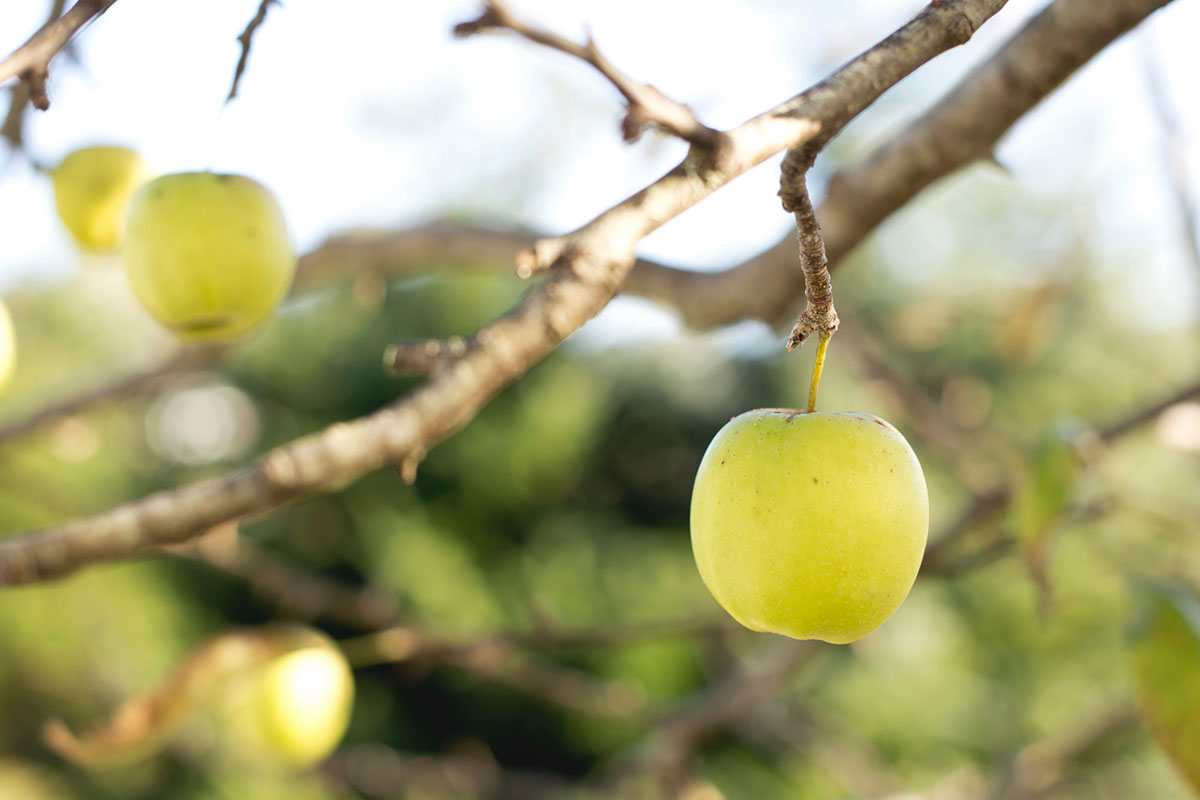 Without proper care, an apple tree is just an ornament - and often not very attractive!
The good news is that you don't need to be an expert to provide your apple tree with everything it needs to thrive.
Choose your apple tree
There are a few things to keep in mind while choosing apple trees. As a beginner, you may want to choose apple varieties that are hardier and bear fruit more quickly. However, there are other things to consider.
growing area
Some of the more common varieties we see in grocery stores, such as Honeycrisp, are unfortunately very difficult to grow. They are often susceptible to insect and fungal infections.
Instead of choosing an apple variety that you are familiar with, do some research beforehand to see what trees grow in your area. Different apple tree species thrive or fail depending on temperature, weather, rainfall, sunlight, and the types of insects and fungi in the vicinity.
Disease resistance
Some apple varieties have been bred to be resistant or even immune to common apple diseases. Thus, it is very easy to grow for home gardeners!
Disease-resistant apple varieties include:
Without proper care, an apple tree is just an ornament - and often not very attractive!
The good news is that you don't need to be an expert to provide your apple tree with everything it needs to thrive.
Choose your apple tree
There are a few things to keep in mind while choosing apple trees. As a beginner, you may want to choose apple varieties that are hardier and bear fruit more quickly. However, there are other things to consider.
growing area
Some of the more common varieties we see in grocery stores, such as Honeycrisp, are unfortunately very difficult to grow. They are often susceptible to insect and fungal infections.
Instead of choosing an apple variety that you are familiar with, do some research beforehand to see what trees grow in your area. Different apple tree species thrive or fail depending on temperature, weather, rainfall, sunlight, and the types of insects and fungi in the vicinity.
Disease resistance
Some apple varieties have been bred to be resistant or even immune to common apple diseases. Thus, it is very easy to grow for home gardeners!
Disease-resistant apple varieties include:
- Liberty - Resistant to fire blight, apple scab, rice rust, powdery mildew
- Pixie Crunch - Resistant to apple scab
- Goldrush - Resistant to apple scab, moderately resistant to powdery mildew and fire blight.
- Crimson Gold - Resistant to apple scab
- Scarlet Topaz - Resistant to apple scab, moderately resistant to fire blight and powdery mildew.
- Freedom - resistance to apple scab, moderate resistance to fire blight
- Florina - Resistant to apple scab, moderately resistant to fire blight and powdery mildew.
- Foundation - Resistant to apple scab, resistant to fire blight, moderately resistant to cedar apple rust, powdery mildew.
size
It may seem obvious, but make sure the apple tree you choose fits your garden! While some species reach a maximum of 15 feet, others can be much larger. It also depends on whether you are buying a standard size tree, a dwarf, or a semi-dwarf variety.
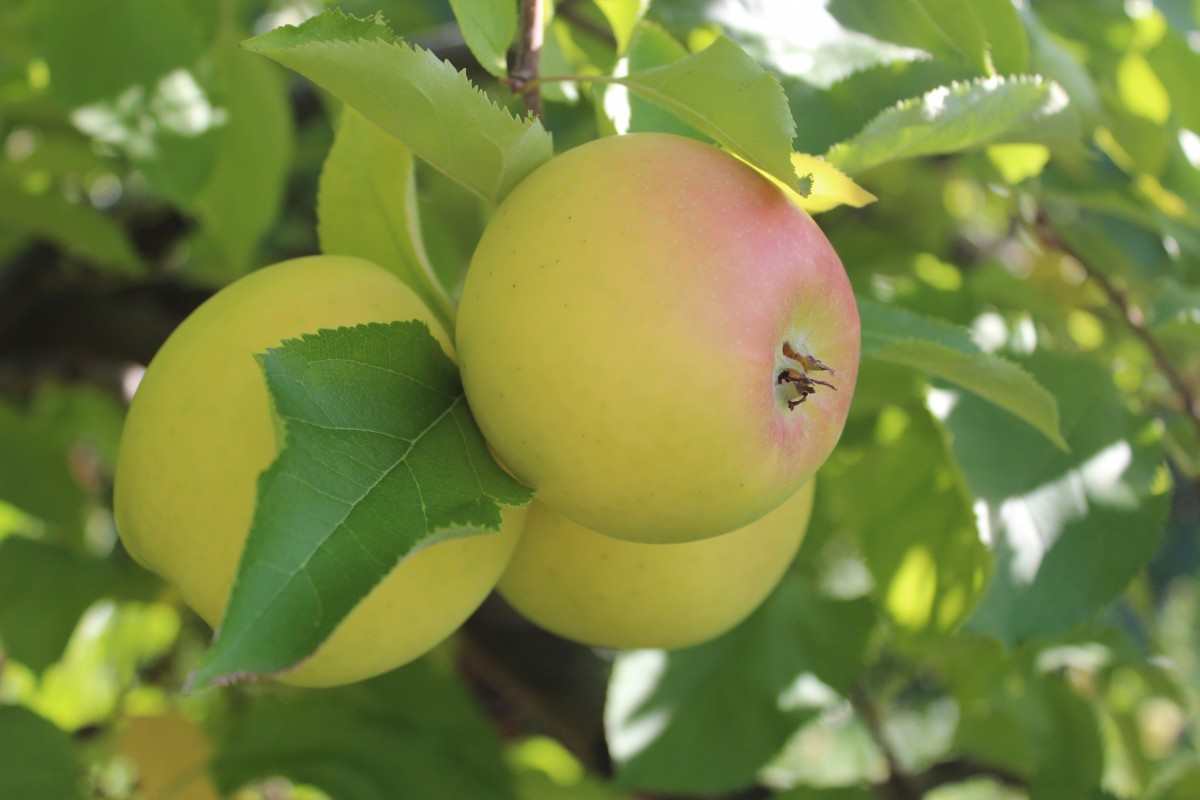
yellow apple tree leaves
Dwarf trees are a popular choice for home gardens. These trees are about 50 percent the height of standard apple trees, so they can be 8 to 15 feet tall at full maturity. Semi-dwarf trees are about 80 percent the size of standard apple trees.
To grow properly and get the most nutrients from the sun and soil, apple trees need 12 to 25 feet of space, depending on their size. That means it's within 12 to 25 feet of any structures, fences, walls, or other plants that could prevent its spread.
reproductive partners
Not every apple tree is independently fertile. Many species are self-sterile, which means they do not produce any fruit.
These varieties require a cross pollinator, usually, another variety of apple trees planted 60 feet or so away (although dwarf varieties should be planted about 20 feet apart).
Before you choose an apple tree variety to plant, do your research to see if it is self-fertile or needs a cross pollinator. If it is self-sterile, find that it is best to combine other apple varieties with this variety.
Plant your apple tree
If you live in a cold climate, the best time to plant apple trees is in spring. Alternatively, if you live in an area with mild winters, early spring or late fall is acceptable.
To find the perfect spot to grow your apple tree, choose a spot far enough away from any other trees, plants, or structures in your garden. The location should be in full sun, which means at least six hours of direct sunlight each day.
Make sure the location has good drainage and clay soil, if possible. Do not plant an apple tree in a depression or other low point, as this is prone to the formation of pockets of moisture or frost.
It is a good idea to do a soil test before planting your tree to check the soil ph. The ideal soil for growing apple trees is between 6.0 and 7.0.
If the pH is too low, your tree will be susceptible to disease. However, you always have the option of treating unsuitable soil with lime or sulfur to improve the ph.
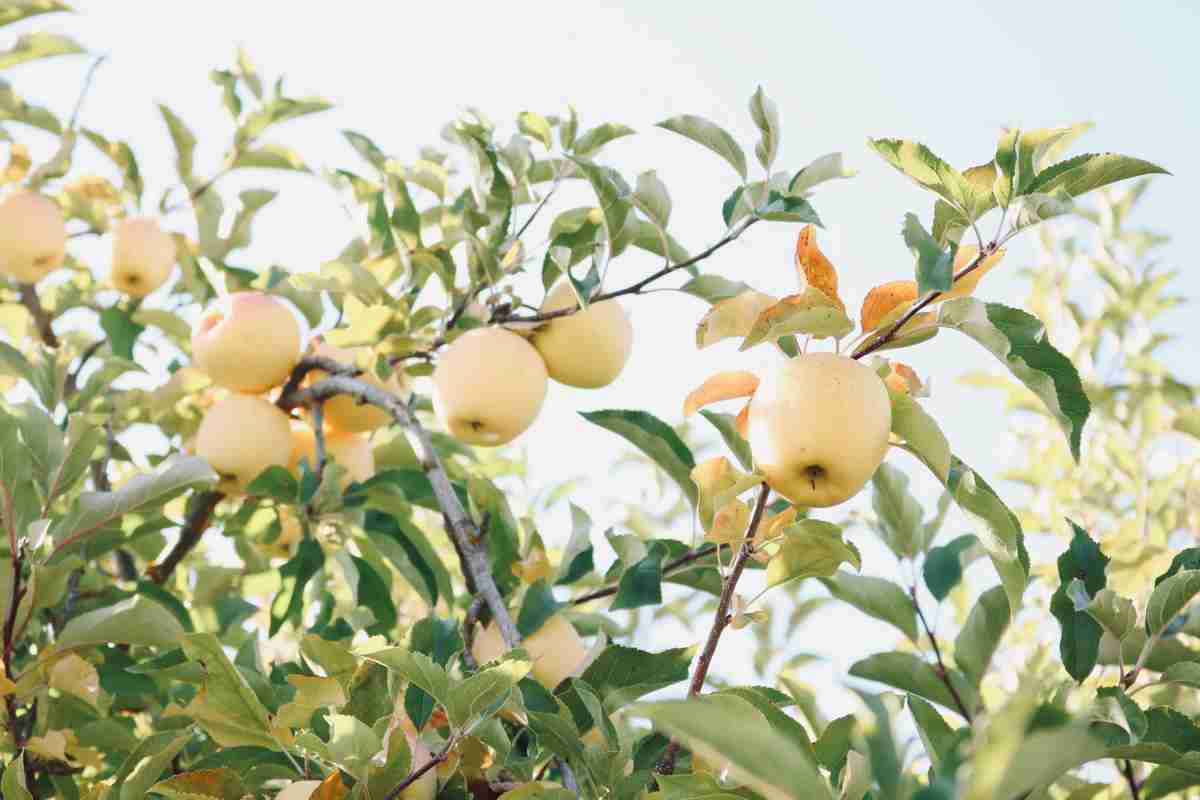
yellow dots on apple tree leaves
How do we grow an apple tree?
To plant an apple tree, clear the surrounding ground to a diameter of about four feet. Remove any growth until you have bare dirt. If you are planting a rootstock, you will need a hole two feet deep and twice the width of the root ball.
Bury the root stock loosely, but leave the topsoil. Water deeply immediately after planting. As the tree begins to spread its roots, it will need more water. About a year after planting, you can switch to watering mature apple trees once every 10 days.
Prune your apple tree
Annual pruning of an apple tree is essential to its long-term health. Scheduled pruning ensures that all the necessary nutrients reach the most important parts of the plant.
Be sure to prune your apple tree annually, usually in late winter. Focus on removing side branches or dead ends and opening the canopy.
Provide sunshine, shade, and water
As mentioned above, apple trees need full sun. This means they should get at least six hours of sun each day, although eight or more hours is ideal.
This is another reason why you should plant a tree in a large area, so there are no trees or structures nearby that would block it from reaching the sun.
Winter tree care
When the apple harvest is over, it's time to start thinking about winter and how to protect your trees when temperatures drop below freezing.
Some apple varieties do very well in cool temperatures and require only moderate care, while others prefer warmer climates. If you live in a place with very cold winters, be sure to choose a variety of apple trees that can tolerate the cold.
There are a few things you should do to protect your apple tree during the winter.

apple tree leaves turning yellow
Sort on time
Do not prune your apple tree in the fall, as this will encourage growth as cooler temperatures begin. Instead, aim for annual pruning in late winter, before the apple tree blooms.
Be sure to use clean pruning shears to reduce the risk of spreading bacteria. Focus on removing dead or severed branches, and shape the tree into an open "cup."
Good summer care
Yes, you read that right – the best way to protect your apple trees during the winter is to care for them when the weather warms up.
Practice deep water during the summer and fall. This will help your tree's roots grow deeper, which will keep it healthy through the colder months. Be sure to fertilize during the warmer months as well, which will boost your tree's health through the winter.
Clean up your yard
When autumn comes, it is time to put your garden in order. Trim your leaves and trim your garden, especially around fruit trees. This reduces the chance of insects hiding in nearby tall grass or leaf piles.
It also reduces the risk of catching harmful fungal spores, which can invisibly infect your tree during the winter and begin to affect it after blooming in the spring.
Winter maintenance training
Even if your apple tree is very cold, you should still take steps to protect it from the cold. After the first freeze of the year, use white latex paint to cover the south-facing side of the tree. This is because melting snow can crack the bark, damaging or injuring the tree.
Likewise, be sure to use plastic sheeting or wire mesh to wrap the tree trunk. This will protect it from rodents trying to strip its bark for food or shelter.

apple tree pollination chart
Pollination of the apple tree
Apple trees are pollinated in several ways: self-fertilization, natural pollination, human-directed hybrid pollination, and grafting.
How does vaccination work?
Self fertilization
Self-fertilizing apple trees, as the name suggests, do not require cross pollination and produce fruit on their own. However, planting two self-fertilizing cultivars can significantly increase yields on both trees.
Self-fertile apple varieties include Cortland, Empire, Gala, Granny Smith, Grimes Golden, Jonathan, and Spartan.
Fertile apple varieties can also be used as pollinators for sterile varieties.
Cross pollination
Cross-pollination refers to the practice of planting two complementary apple varieties near each other to increase the fruit yield of both. Natural cross-pollination occurs when bees carry pollen between each tree.
Human-led cross-pollination can also help, usually as support to natural processes. There are several ways apple trees share pollen. Some growers even take a regular paint brush and "paint" pollen from one tree onto another flower!
What are well-pollinated varieties?
Some of the most successful pairings include:
Baldwin and reproductive cancer
Delicious red and ice
Gala and Fuji, Breabourne, or Spartan
McIntosh and the Northern Spy
Honeygold, Honeycrisp, Granny Smith, or Empire.
Varieties that are not good pollinators include Baldwin, Winsab, Mutsu, Jonagold, Gravenstein, and King. However, this does not mean that these varieties cannot be grown, even by home gardeners.
This means they need to be fertilized by an effective pollinator, usually a crab apple.
When do you start expecting fruit?
The general rule is that apple trees start bearing fruit three to four years after planting. However, this can vary widely depending on the growing conditions, the care you provide, the variety of apple trees, cross pollinators, and many other factors.
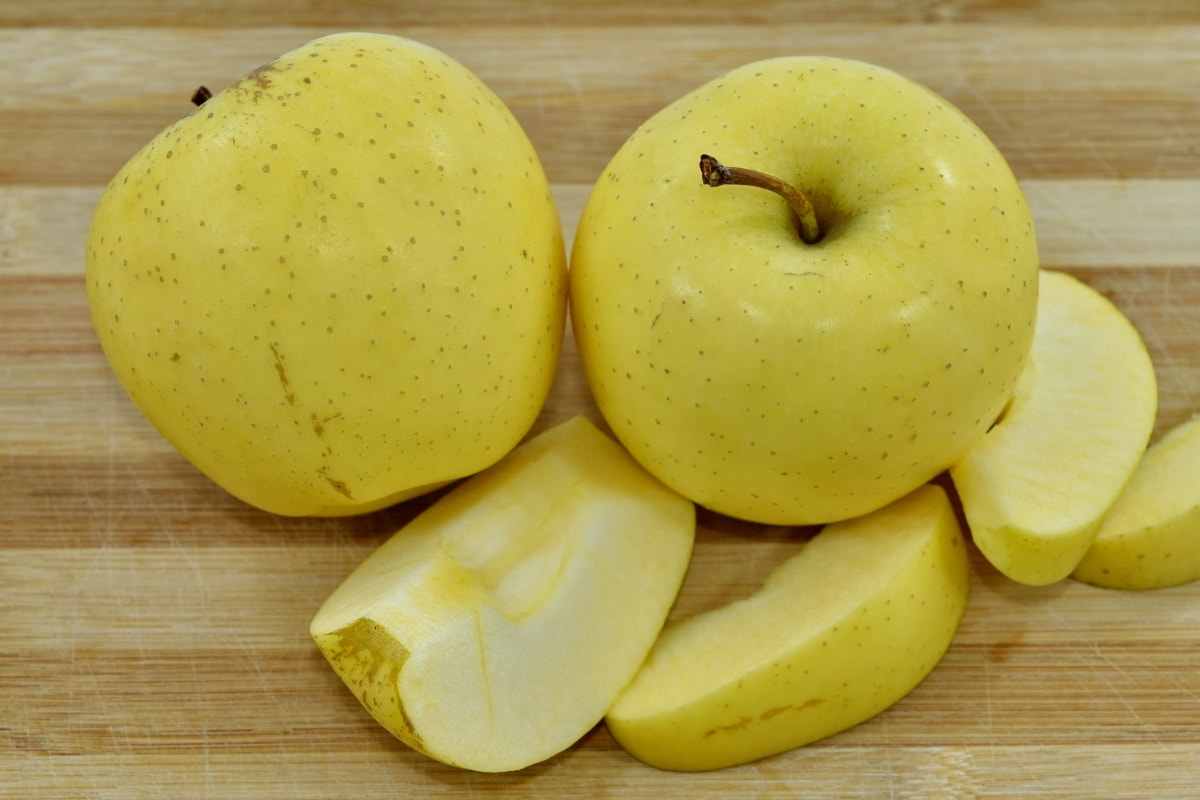
apple tree cross pollination
Regular pruning and basic care can encourage early fruiting, but be sure not to over-encourage, as this can hinder healthy growth later.
Diseases and pests of apple trees
Apple trees are susceptible to some bacterial and fungal infections, although these are widely dependent on the apple cultivar, growing conditions, and geographic region.
It is important to check your apple tree regularly for signs of pests and diseases so that you can start treating it as soon as possible.
Not every disease that affects apple trees actually kills them. Some of them are only superficial, affecting the appearance of fruits, leaves, and branches. Others may kill the tree completely.
The most common apple tree diseases include:
Try the apple
- Powdery mildew
- fire blight
- Spot stains and flyspeck
- Cork spot
- Phytophthora rot
- Rice rust
- black rot
- white rot
- bitter burn
Insect infestations can also occur on apple trees. The most common pests affecting apple trees include:
Round head apple tree borer
- Apple larva
- Coding worm
- curculio plum
- San Jose Scale
- European red worm
- Red banded leaves
- Green fruit insects
- Leaf hoppers
- of pink apples
- of the mysterious apple
- Japanese beetle
- Protection of the bark
- Bark protection can also be essential for apple trees to protect them not only from cold winter temperatures, but also from larger pests including rabbits, mice, rats, and sometimes beavers.
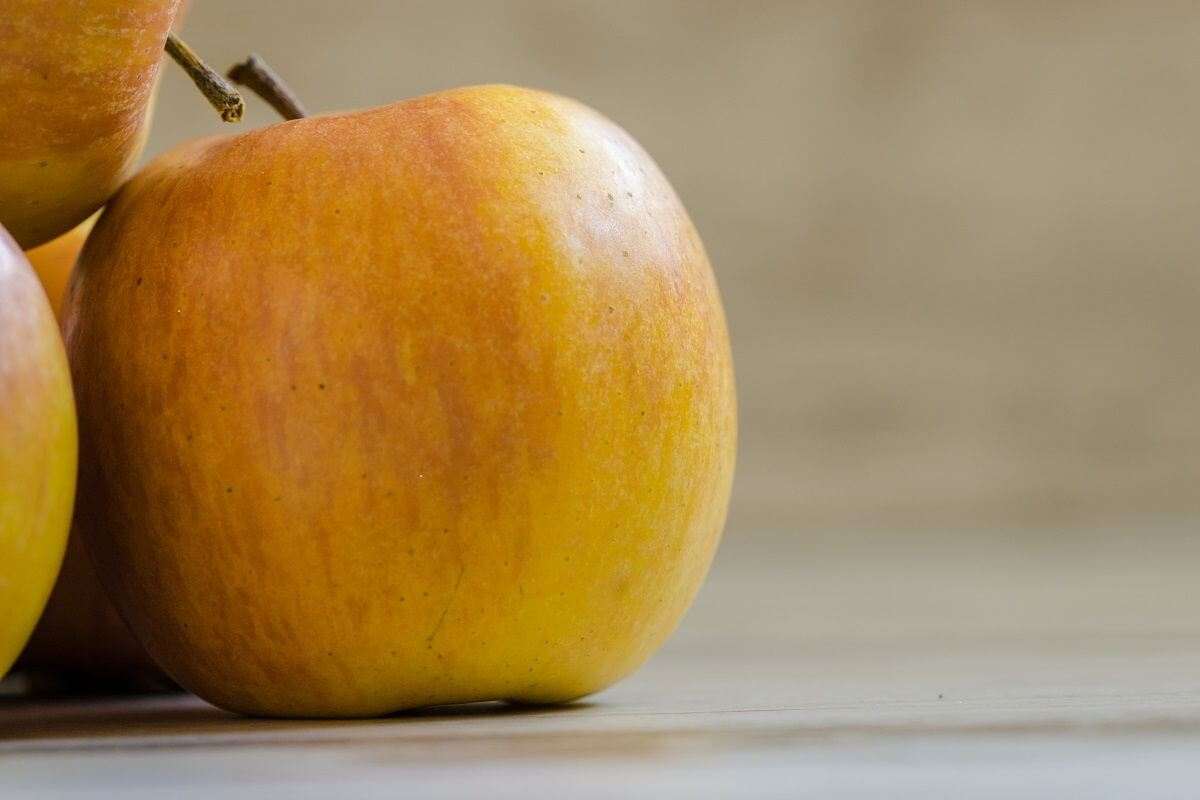 Harvesting and storage
Apple harvest times vary greatly depending on the cultivar, with early varieties being ready in early May and continuing through November.
However, most varieties are ready for harvest between August and October. It will also be somewhat different depending on your growing region.
How to store apples
The shelf life of apples varies by variety. However, in general, apples are best stored at 35-38 degrees and 85 percent humidity. This corresponds to a standard refrigerator temperature and will extend its shelf life by several weeks.
Cooking with apples
There are endless ways to cook with apples, from making classic apple pie to cider, baked apples, and apple cider. Different varieties are best for cooking, baking, juicing, and eating fresh.
Apple varieties that are good for cooking include Jonagold, Honeycrisp, Granny Smith, Winesap, Pink Lady, Braeburn, and Mutsu. Try making some homemade apple cider over a classic fall dessert like ham slices, cheesy apples, or oatmeal apple muffins.
How do you care for an apple tree in the first year?
The biggest difference between young and mature apple trees is the amount of water they need.
Some gardeners recommend watering young apple trees three times a week—if you have loamy or clay soil that retains some water. Sandy soils can drain very quickly and require frequent watering.
However, this routine continues until the tree is three or four months old, at which point you should prune the root system to avoid flooding.
Harvesting and storage
Apple harvest times vary greatly depending on the cultivar, with early varieties being ready in early May and continuing through November.
However, most varieties are ready for harvest between August and October. It will also be somewhat different depending on your growing region.
How to store apples
The shelf life of apples varies by variety. However, in general, apples are best stored at 35-38 degrees and 85 percent humidity. This corresponds to a standard refrigerator temperature and will extend its shelf life by several weeks.
Cooking with apples
There are endless ways to cook with apples, from making classic apple pie to cider, baked apples, and apple cider. Different varieties are best for cooking, baking, juicing, and eating fresh.
Apple varieties that are good for cooking include Jonagold, Honeycrisp, Granny Smith, Winesap, Pink Lady, Braeburn, and Mutsu. Try making some homemade apple cider over a classic fall dessert like ham slices, cheesy apples, or oatmeal apple muffins.
How do you care for an apple tree in the first year?
The biggest difference between young and mature apple trees is the amount of water they need.
Some gardeners recommend watering young apple trees three times a week—if you have loamy or clay soil that retains some water. Sandy soils can drain very quickly and require frequent watering.
However, this routine continues until the tree is three or four months old, at which point you should prune the root system to avoid flooding.
How useful is this article to you?
Average Score
5
/
Number of votes:
1
 Without proper care, an apple tree is just an ornament - and often not very attractive!
The good news is that you don't need to be an expert to provide your apple tree with everything it needs to thrive.
Choose your apple tree
There are a few things to keep in mind while choosing apple trees. As a beginner, you may want to choose apple varieties that are hardier and bear fruit more quickly. However, there are other things to consider.
growing area
Some of the more common varieties we see in grocery stores, such as Honeycrisp, are unfortunately very difficult to grow. They are often susceptible to insect and fungal infections.
Instead of choosing an apple variety that you are familiar with, do some research beforehand to see what trees grow in your area. Different apple tree species thrive or fail depending on temperature, weather, rainfall, sunlight, and the types of insects and fungi in the vicinity.
Disease resistance
Some apple varieties have been bred to be resistant or even immune to common apple diseases. Thus, it is very easy to grow for home gardeners!
Disease-resistant apple varieties include:
Without proper care, an apple tree is just an ornament - and often not very attractive!
The good news is that you don't need to be an expert to provide your apple tree with everything it needs to thrive.
Choose your apple tree
There are a few things to keep in mind while choosing apple trees. As a beginner, you may want to choose apple varieties that are hardier and bear fruit more quickly. However, there are other things to consider.
growing area
Some of the more common varieties we see in grocery stores, such as Honeycrisp, are unfortunately very difficult to grow. They are often susceptible to insect and fungal infections.
Instead of choosing an apple variety that you are familiar with, do some research beforehand to see what trees grow in your area. Different apple tree species thrive or fail depending on temperature, weather, rainfall, sunlight, and the types of insects and fungi in the vicinity.
Disease resistance
Some apple varieties have been bred to be resistant or even immune to common apple diseases. Thus, it is very easy to grow for home gardeners!
Disease-resistant apple varieties include:





 Harvesting and storage
Apple harvest times vary greatly depending on the cultivar, with early varieties being ready in early May and continuing through November.
However, most varieties are ready for harvest between August and October. It will also be somewhat different depending on your growing region.
How to store apples
The shelf life of apples varies by variety. However, in general, apples are best stored at 35-38 degrees and 85 percent humidity. This corresponds to a standard refrigerator temperature and will extend its shelf life by several weeks.
Cooking with apples
There are endless ways to cook with apples, from making classic apple pie to cider, baked apples, and apple cider. Different varieties are best for cooking, baking, juicing, and eating fresh.
Apple varieties that are good for cooking include Jonagold, Honeycrisp, Granny Smith, Winesap, Pink Lady, Braeburn, and Mutsu. Try making some homemade apple cider over a classic fall dessert like ham slices, cheesy apples, or oatmeal apple muffins.
How do you care for an apple tree in the first year?
The biggest difference between young and mature apple trees is the amount of water they need.
Some gardeners recommend watering young apple trees three times a week—if you have loamy or clay soil that retains some water. Sandy soils can drain very quickly and require frequent watering.
However, this routine continues until the tree is three or four months old, at which point you should prune the root system to avoid flooding.
Harvesting and storage
Apple harvest times vary greatly depending on the cultivar, with early varieties being ready in early May and continuing through November.
However, most varieties are ready for harvest between August and October. It will also be somewhat different depending on your growing region.
How to store apples
The shelf life of apples varies by variety. However, in general, apples are best stored at 35-38 degrees and 85 percent humidity. This corresponds to a standard refrigerator temperature and will extend its shelf life by several weeks.
Cooking with apples
There are endless ways to cook with apples, from making classic apple pie to cider, baked apples, and apple cider. Different varieties are best for cooking, baking, juicing, and eating fresh.
Apple varieties that are good for cooking include Jonagold, Honeycrisp, Granny Smith, Winesap, Pink Lady, Braeburn, and Mutsu. Try making some homemade apple cider over a classic fall dessert like ham slices, cheesy apples, or oatmeal apple muffins.
How do you care for an apple tree in the first year?
The biggest difference between young and mature apple trees is the amount of water they need.
Some gardeners recommend watering young apple trees three times a week—if you have loamy or clay soil that retains some water. Sandy soils can drain very quickly and require frequent watering.
However, this routine continues until the tree is three or four months old, at which point you should prune the root system to avoid flooding.
